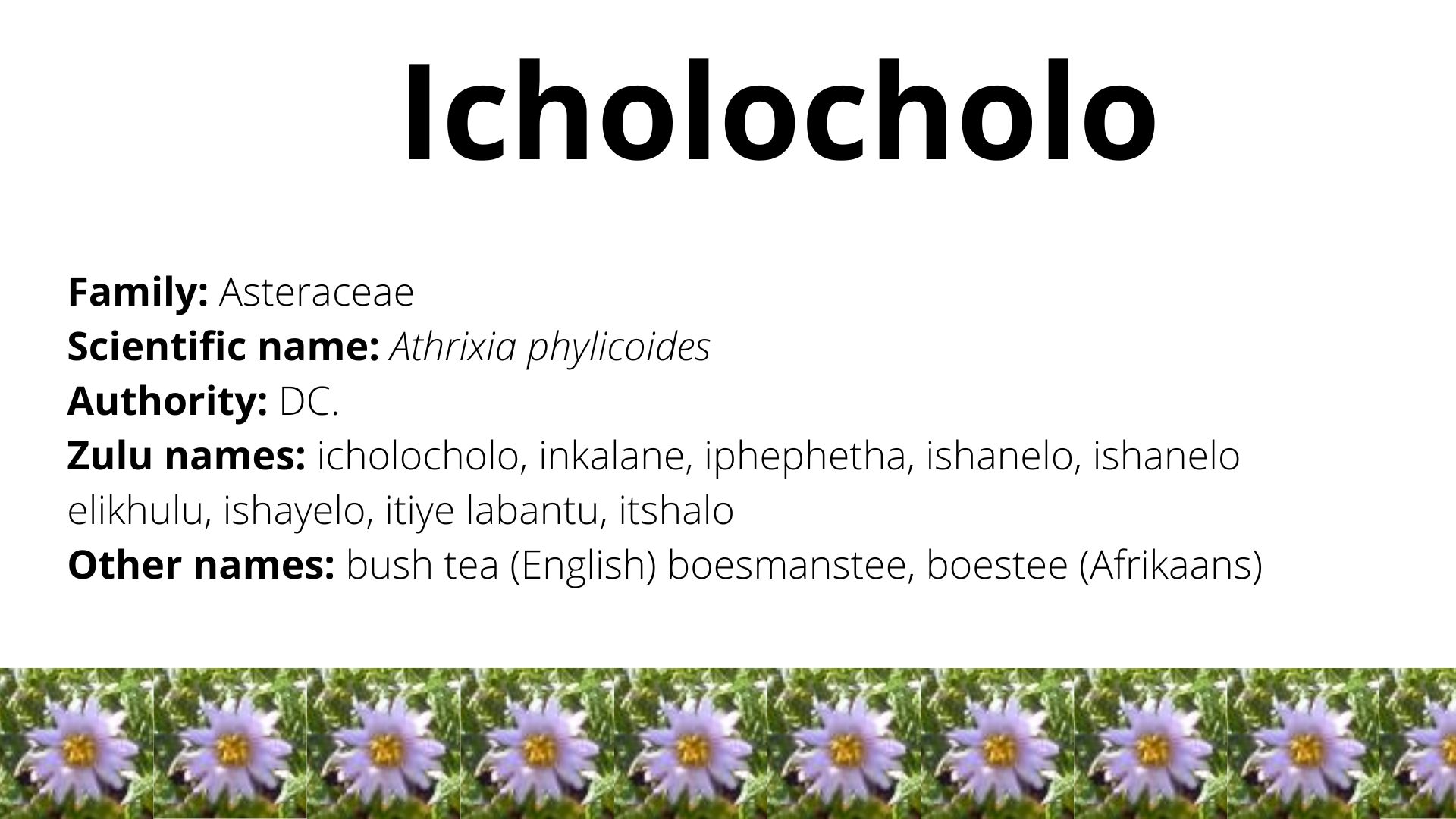Family: Asteraceae
Scientific name: Athrixia phylicoides
Authority: DC.
Zulu names: icholocholo, inkalane, iphephetha, ishanelo, ishanelo elikhulu, ishayelo, itiye labantu, itshalo
Other names: bush tea (English) boesmanstee, boestee (Afrikaans)
Description: A. phylicoides is a shrub with soft leaves that are dark green and glossy above and grey-white and smooth underneath and purple or mauve daisy-like flowers. It is widespread in the coastal and Drankensberg regions, occurring in bushveld, grassland, forest, and rocky hillside habitats.
Uses:
- The leaves and twigs are used to make an infusion that is taken orally as herbal tea.
- The leaves are administered as enema to treat uncontrollable menstruation.
- The leaves are used to make decoction to soak sore feet after scarification.
- The roots are used to make a decoction that is taken to treat a cough and influenza.
- The roots and leaves are used as an anthelmintic, to expel parasites.
- The plant is administered as a bathing agent and used to treat skin ailments, such as acne, boils, sores, and wounds.
- The plant is used for cleansing or purifying blood.
- The plant is used to treat heart problems, such as hypertension.
- The plant is used to detoxify the body and to relieve headaches.
- The plant is used as a purgative and for diabetes.
- The plant is used to treat diarrhoea and venereal disease.
- The plant is used as an aphrodisiac, sexual stimulant.
- The branchlets are tied together and used as a broom.
References and further reading:
- Fox, F.W. and Norwood Young, M.E., 1982. Food from the veld. Delta Books, Johannesburg.
- Joubert, E., Gelderblom, W.C.A., Louw, A. and De Beer, D., 2008. South African herbal teas: Aspalathus linearis, Cyclopia spp. and Athrixia phylicoides—A review. Journal of ethnopharmacology, 119(3), pp.376-412.
- Kleinhans, R., Singh, S., Kishore, N. and Lall, N., 2017. Investigation towards propagation and cosmeceutical application of Athrixia phylicoides DC. South African Journal of Botany 112, pp.319–321.
- Lerotholi, L., Chaudhary, S.K., Combrinck, S. and Viljoen, A., 2017. Bush tea (Athrixia phylicoides): A review of the traditional uses, bioactivity and phytochemistry. South African Journal of Botany, 110, pp.4-17.
- Lerotholi, L., Chen, W. and Combrinck, S., 2023. Athrixia phylicoides. In The South African Herbal Pharmacopoeia (pp. 153-170). Academic Press.
- Mabogo., D., 1990. The ethnobotany of the VhaVenda. M.Sc. dissertation, University of Pretoria, Pretoria.
- Nchabeleng, L., Mudau, F.N. and Mariga, I.K., 2012. Effects of chemical composition of wild bush tea (Athrixia phylicoides DC.) growing at locations differing in altitude, climate and edaphic factors. Journal of Medicinal Plants Research 6, pp. 1662–1666.
- Ngwenya, M.A., Koopman, A. and Williams, R., 2004. Zulu botanical knowledge – an introduction (Ulwazi lwamaZulu ngezimila: isingeniso). National Botanical Institute, Durban.
- Rampedi, I. and Oliver, J., 2005. The use and potential commercial development of Athrixia phylicoides. Acta Academia 37, pp.165–183.
- Roberts, M., 1990. Indigenous healing plants. Southern Book Publishers, Halfway House.
- Van Wyk, B.E. and Gericke, N., 2000. People’s plants. A guide to useful plants of southern Africa. Briza Publications, Pretoria.
- Walker, J., 1996. Wild flowers of KwaZulu-Natal. W.R. Walker Family Trust, Pinetown.
